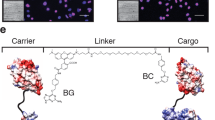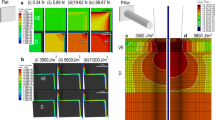Abstract
The skin represents an excellent site for vaccine inoculation due to its natural role as a first line of contact with foreign pathogens and the high local frequency of antigen presenting cells. To facilitate skin-directed immunization, a new technique has been developed (termed microporation) whereby a vaporization process is used to remove tiny areas of the stratum corneum creating microscopic pores that allow access to the underlying viable epidermis. Reporter gene expression was 100-fold increased following application of an adenovirus vector to microporated skin when compared to intact skin. Furthermore, 10–100-fold greater cellular and humoral immune responses were observed following topical administration of an adenovirus vaccine to microporated skin versus intact skin. Hairless mice responded to the microporated adenovirus vaccine equivalently to mice with normal hair follicle distribution demonstrating the activity of the microporated vaccine was not related to follicle count. In a tumor challenge model using a surrogate antigen, microporation increased vaccine efficacy by approximately 100-fold compared to intact skin. Finally, microporation enabled delivery of an adenovirus vaccine carrying a relevant melanoma antigen resulting in the development of auto-immune vitiligo and tumor protection. Thus, the microporation technology has proven to be a reliable and easy method to enable skin-directed vaccination.
This is a preview of subscription content, access via your institution
Access options
Subscribe to this journal
Receive 12 print issues and online access
$259.00 per year
only $21.58 per issue
Buy this article
- Purchase on Springer Link
- Instant access to full article PDF
Prices may be subject to local taxes which are calculated during checkout









Similar content being viewed by others
References
Spellberg B . The cutaneous citadel: a holistic view of skin and immunity. Life Sci 2000; 67: 477–502.
Wan Y et al. Dendritic cells transduced with an adenoviral vector encoding a model tumor-associated antigen for tumor vaccination. Hum Gene Ther 1997; 8: 1355–1363.
Perricone MA et al. Immunogene therapy for murine melanoma using recombinant adenoviral vectors expressing melanoma-associated antigens. Mol Ther 2000; 1: 275–284.
Forg P, von Hoegen P, Dalemans W, Schirrmacher V . Superiority of the ear pinna over muscle tissue as site for DNA vaccination. Gene Ther 1998; 5: 789–797.
Smith A et al. Fluorescein kinetics in interstitial fluid harvested from diabetic skin during fluorescein angiography: implications for glucose monitoring. Diabetes Technol Therapeutics 1999; 1: 21–27.
Barry BW . Novel mechanisms and devices to enable successful transdermal drug delivery. Eur J Pharm Sci 2001; 14: 101–114.
McAllister DV, Allen MG, Prausnitz MR . Microfabricated microneedles for gene and drug delivery. Ann Rev Biomed Eng 2000; 2: 289–313.
Chen D et al. Epidermal immunization by a needle-free powder delivery technology: immunogenicity of influenza vaccine and protection in mice. Nat Med 2000; 6: 1187–1190.
Haensler J et al. Intradermal DNA immunization by using jet-injectors in mice and monkeys. Vaccine 1999; 17: 628–638.
Misra A, Ganga S, Upadhyay P . Needle-free, non-adjuvanted skin immunization by electroporation-enhanced transdermal delivery of diphtheria toxoid and a candidate peptide vaccine against hepatitis B virus. Vaccine 1999; 18: 517–523.
Wan Y et al. Genetically modified dendritic cells prime autoreactive T cells through a pathway independent of CD40L and interleukin 12: implications for cancer vaccines. Cancer Res 2000; 60: 3247–3253.
Hitt MM, Addison CL, Graham FL . Human adenovirus vectors for gene transfer into mammalian cells. Adv Pharmacol 1997; 40: 137–206.
Fan H, Lin Q, Morrissey GR, Khavari PA . Immunization via hair follicles by topical application of naked DNA to normal skin. Nat Biotechnol 1999; 17: 870–872.
Tang DC, Shi Z, Curiel DT . Vaccination onto bare skin. Nature 1997; 388: 729–730.
Shi Z et al. Protection against tetanus by needle-free inoculation of adenovirus- vectored nasal and epicutaneous vaccines. J Virol 2001; 75: 11 474–11 482.
Banga AK . Electrically Assisted Transdermal and Topical Drug Delivery. Taylor & Francis: London, 1998.
Bramson JL, Wan YH . The efficacy of genetic vaccination is dependent upon the nature of the vector system and antigen. Expert Opin Biol Ther 2002; 2: 75–85.
Steitz J et al. Genetic immunization of mice with human tyrosinase-related protein 2: implications for the immunotherapy of melanoma. Int J Cancer 2000; 86: 89–94.
Bowne WB et al. Coupling and uncoupling of tumor immunity and autoimmunity. J Exp Med 1999; 190: 1717–1722.
Steitz J, Bruck J, Knop J, Tuting T . Adenovirus-transduced dendritic cells stimulate cellular immunity to melanoma via a CD4(+) T cell-dependent mechanism. Gene Ther 2001; 8: 1255–1263.
Overwijk WW et al. Vaccination with a recombinant vaccinia virus encoding a “self” antigen induces autoimmune vitiligo and tumor cell destruction in mice: requirement for CD4(+) T lymphocytes. Proc Natl Acad Sci USA 1999; 96: 2982–2987.
Pardoll DM . Inducing autoimmune disease to treat cancer. Proc Natl Acad Sci USA 1999; 96: 5340–5342.
Chen PW et al. Therapeutic antitumor response after immunization with a recombinant adenovirus encoding a model tumor-associated antigen. J Immunol 1996; 156: 224–231.
Zhai Y et al. Antigen-specific tumor vaccines. Development and characterization of recombinant adenoviruses encoding MART1 or gp100 for cancer therapy. J Immunol 1996; 156: 700–710.
Hirschowitz EA et al. Adenovirus-mediated expression of melanoma antigen gp75 as immunotherapy for metastatic melanoma. Gene Ther 1998; 5: 975–983.
Glenn GM et al. Transcutaneous immunization: a human vaccine delivery strategy using a patch. Nat Med 2000; 6: 1403–1406.
Glenn GM, Rao M, Matyas GR, Alving CR . Skin immunization made possible by cholera toxin. Nature 1998; 391: 851.
Chen D et al. Epidermal powder immunization induces both cytotoxic T-lymphocyte and antibody responses to protein antigens of influenza and hepatitis B viruses. J Virol 2001; 75: 11 630–11 640.
Ng P et al. An enhanced system for construction of adenoviral vectors by the two-plasmid rescue method. Hum Gene Ther 2000; 11: 693–699.
Bramson J et al. Construction of a double recombinant adenovirus vector expressing a heterodimeric cytokine: in vitro and in vivo production of biologically active interleukin-12. Hum Gene Ther 1996; 7: 333–342.
Bramson JL, Hitt M, Gauldie J, Graham FL . Pre-existing immunity to adenovirus does not prevent tumor regression following intratumoral administration of a vector expressing IL-12 but inhibits virus dissemination. Gene Ther 1997; 4: 1069–1076.
Acknowledgements
JLB is supported by an Rx & D–Health Research Foundation/CIHR Career Award in Health Research.
Author information
Authors and Affiliations
Rights and permissions
About this article
Cite this article
Bramson, J., Dayball, K., Evelegh, C. et al. Enabling topical immunization via microporation: a novel method for pain-free and needle-free delivery of adenovirus-based vaccines. Gene Ther 10, 251–260 (2003). https://doi.org/10.1038/sj.gt.3301886
Received:
Accepted:
Published:
Issue Date:
DOI: https://doi.org/10.1038/sj.gt.3301886
Keywords
This article is cited by
-
Transdermal drug delivery systems for fighting common viral infectious diseases
Drug Delivery and Translational Research (2021)
-
Therapeutic efficacy of nanoparticles and routes of administration
Biomaterials Research (2019)
-
In Vivo, In Situ Imaging of Microneedle Insertion into the Skin of Human Volunteers Using Optical Coherence Tomography
Pharmaceutical Research (2011)
-
Enabling skin vaccination using new delivery technologies
Drug Delivery and Translational Research (2011)
-
Transdermal drug delivery
Nature Biotechnology (2008)



